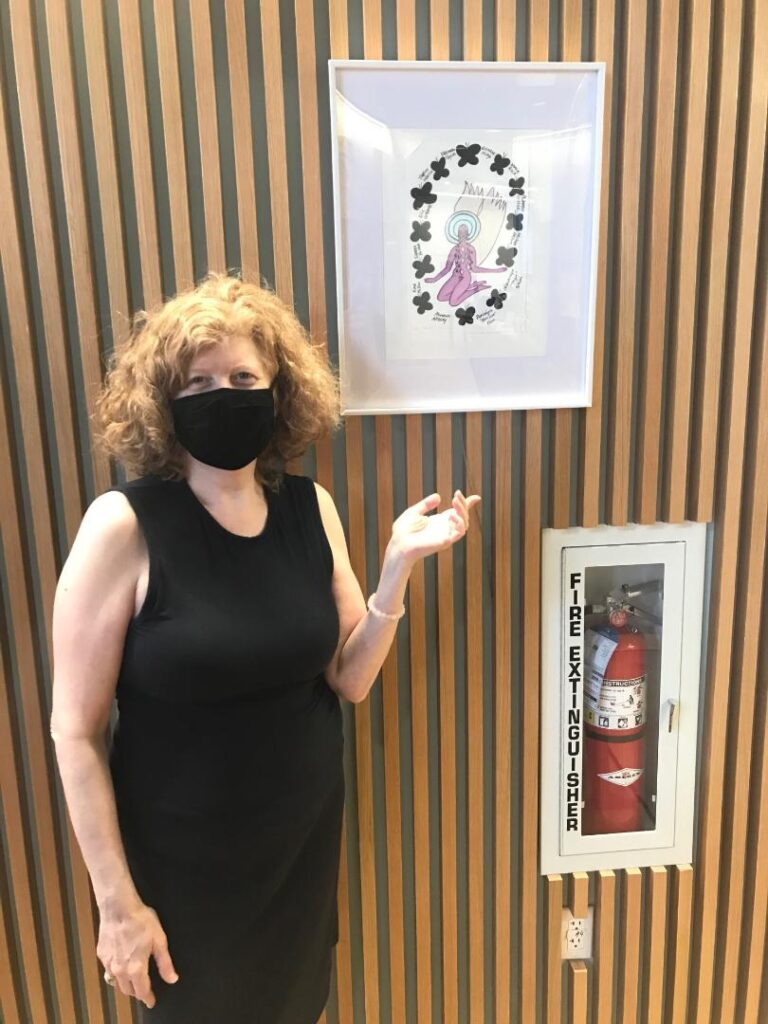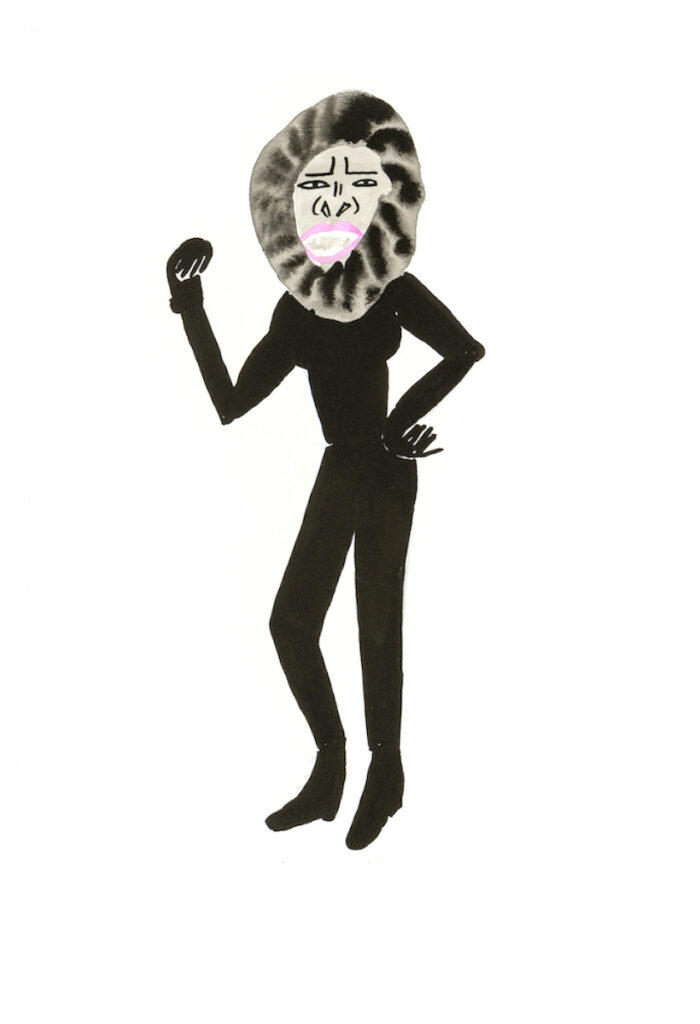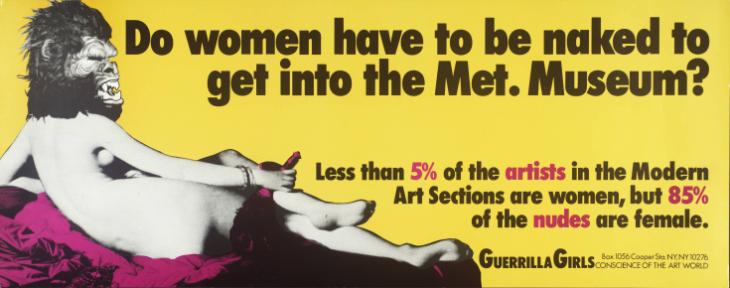Figurative artist Amy Chaiklin is a “storyteller.” Her female imagery, ranging from witches, goddesses, superwomen, and the women who have supported and inspired Chaiklin, reveals a wide range of women’s experiences. This episode includes a conversation with Amy and includes the fascinating “true” story behind her 1983 mural Bowery Beauties in the context as a working, woman artist.

Highlighted in the episode are women from Chaiklin’s series, “Cultured Pearls Portrait.” Below is Guerilla Girls–activist female artists who “blast institutions for their bad behavior and discriminatory practices.” I included their iconic work, “Do Women Have to Be Naked to Get into the Met Museum?”



Resources for this episode include Amy Chaiklin website, Margalit Start Up City, Tate Museum, the writings of Rebecca Gop, Sonia MacKay, Gabi Book, and the Village Voice. Follow Amy Chaiklin on Instagram @amychaiklin
Script
Welcome to Episode 119: Amy Chaiklin: Expression of Women’s Experiences
From an early painting by Amy Chaiklin, when she was 15 years old, we see the beginnings of her artistic life that combines a meditative practice with drawing—we see elements that will evolve through her visual journeys into the depths of the female world. The painting “shows a girl at the beach with her eyes directed to a sea-shell in her hands. Sand and sea, water and wind, they are the forces of nature which set the stage for the story of the teenage girl and the sea-shell. Her meditative thoughts glide over the canvas with fine brush strokes. It is a sensuous journey into the inner most chambers of the conch and into the heart of the universe.” The practice of Meditation coupled with Chaiklin’s female perspective of the female life, pervade in her canvases of stylized women. From each women is a narrative—Chaiklin herself has said, “I am a storyteller.” What I personally find so fascinating is the way Chaiklin breaks open through the surface of delicate lines that build up her female figures, multi-dimensional aspects of her sitter’s life, her sensuality, her role, a range of representations, a broad range of female personas, from goddesses to witches to femme fatale, to superwomen, to women who directly supported her art. This episode includes a conversation with Chaiklin and together we will follow into the stories of Chaiklin’s women.
I met and had a wonderful visit with Chaiklin in New York a couple of weeks ago. It is such a pleasure and privilege to spend one to one time with women artists in person. We initially met in SOHO at the Margalit Start Up City on Grand Street. The organization provides a strong base for startups connecting them to top investors, leading executives, entrepreneurs and universities with the NY ecosystem. Margalit Start Up City is the host for the exhibition “Truth to Power.” The show is co-curated by Sule Marquez-Monsanto and Amir Diop. and co-organized by Soho Renaissance Factory, and the NYSS Alumni Association. The show gives contemporary artists “a chance to express their views on the delay in opening of a retrospective of Philip Guston–he is recognized for making figurative work about difficult political and social themes.–this includes his famed paintings and drawings of hooded Klu Klux Klan figures and the role of art and artists in speaking truth to power and improving society as a whole.”
Chaiklin’s submission “Say Their Name,” was selected to be in the exhibition. The work incorporates her signature stylized female figure, in this work her representation of the Goddess is front and center. She is surrounded by a circle of flat, black butterflies. In between each black-colored butterfly–they are represents death is the name of a person of color who was killed at the hand of police officers. The names are hand written in the artist’s script. They include George Floyd, Breonna Taylor, Ahmaud Arbery. The goddess nude is kneeling, her body is enhanced by her full breasts and a few strokes indicate pubic hair. Atop her head appears to be a halo or crown. Fastened behind her are a set of wings. Her eyes are closed, tears fall in large droplets, her arms are open, palms of her hands are faced up. She prays for the world to heal. The work, as Chaiklin described, brings awareness to prevailing racism in the United States.
What Chaiklin draws from her multitude of women portraits, like the goddess in “Say Their Name,” is her “perception of each women’s essence.” I asked Chaiklin what inspired her figures, the shape–her stylized representations of women through a few, “comic-like” strokes from her pen. She said her drawing is intuitive. Her practice includes meditation followed by drawing images she sees.
If you collect her figures of women and line them up in a row or congregate them in a circle, what you see in each woman is the similar, lofty, curvatures lines that make up her body. They appear at first simplistic, even animated. Their individuality is revealed through hairstyles, fashion choices and I love this, their personal stance, they can be described as ‘power stances’–there is an innate strength in each of her women and most confront the viewer through a direct gaze.
Let’s explore a delightful series titled Cultured Pearls Portraits, “honoring the sisterhood of real women artists and curators that have inspired, influenced and supported my work.” what a wonderful homage to women who supported Chaiklin and her art. Chaiklin is very vocal about artists being supportive of other artists, especially women–she refers to women supporting women as “sisterhood.” Through this series of figures, her visual representations of women in the arts, we see Chaiklin’s personal connection with them. Chaiklin says, “These works are based on photographs that I have taken or sourced on social media. I paint my perception of each women’s essence by drawing their personal stance, individual hairstyles, and fashion choices. For each women her eyes face forward looking directly out at the world. This helps to create a sense of empowerment for each woman. For me, that direct gaze does command a strong presence.
Allow me to bring you through some of the notable women in this ongoing series. First up–painter Deborah Wasserman whose visceral works melds women and landscape stirred by Ecofeminist themes. In a scooped neck black fitted dress with a flared skirt and black boots, a burst of orange lines accent the folds of her flared skirt. Her orange lipstick is the same shade of her bright beaded necklace. Her hands are folded in front of her; she has this demure expression on her face. Chaiklin shares, Deborah “inspires me with her passionate figurative acrylic, oil and cloth paintings on canvases that merge women within the landscape.
Black female painter Emma Amos, known for her figurative paintings that depict bodies in free fall inspired Chaiklin with “her expressive, colorful, paintings of the black body which she fiercely painted long before images of the black body were accepted.” I love Chaiklin’s interpretation of Emma, her stance is relaxed, clasped hands are on one hip–from a flurry of curls we see her wide smile.
The Guerilla Girls inspired Chaiklin for their work in “giving a voice to female artists. They are still speaking and the art world is now listening.” The Guerilla Girls are anonymous feminist activist artists. They wear gorilla masks in public and name themselves after famous dead women like Georgia O’Keeffe. They “use facts, humor and outrageous visual to expose gender and ethnic bias as well as corruption in politics, art, film and pop culture. They are especially known for their posters that “blast institutions for their bad behavior and discriminatory practices.” Their 1989 iconic poster is “Do Women Have to Be Naked to Get into the Met Museum?” is accompanied by a nude figure–the image is taken from Odalisque and Slave painted by French artist Ingres. In their rendered version she is wearing a gorilla mask. The poster was inspired after the group walked through the Met and counted the ratio of female artists to female nudes. What they discovered was that ‘less than 5% of the artists in the Modern Art Sections are women, but 85% of the nudes are female’ Chaiklin’s representation is a female figure dressed completely in black, her face is covered in a Gorilla mask with a thickly drawn open pink lips. one hand is on her hip, the other is raised in an assertive fist.
Marilyn Minter–Chaiklin says, “her wild, lush paintings, photographs and videos of nude women grab my attention and don’t let go. Minter inspired me as her work gives women agency over their own bodies and sexuality.” Minters paintings and photographs are so sensual–her work examines contemporary notions of beauty through depictions of cropped female bodies laden with jewels, and couture accessories. Chaiklin presents us with delicate figure, page boy haircut, bright red lipstick–her black dress is paired with white ankle boots. The dress is accented with a white pin designed with the word Resist-it reveals her embrace for activism.
Some of her pictures, unlike the portraits that open up the viewer to the inner life of her women, act out women’s experiences and notably the feminine libido–sexual desires and fantasies. The women are rendered in the same naive child like lines, but bolder, sharper, more vibrant colors–their sexuality is pronounced through super slim waists and large breasts and “inviting hair.” She creates scenes that include male figures, erotic narratives, “painted plays that act out stories of sex, love and passion.” From the writer Rebecca Gop, ” Chaiklin spins the scenes of a female life with the fine yarn of her own fantasies and experiences. Each of her paintings is a story. Through her representations of a broad spectrum of women, what is exposed are a broad range of human emotions and experiences of Chaiklin’s inner life. Her figures express or are an extension of Chaiklin’s openness, her humor, but also her intensity, her female perspective. Chaiklin is a storyteller–She makes visual the stories of women.
